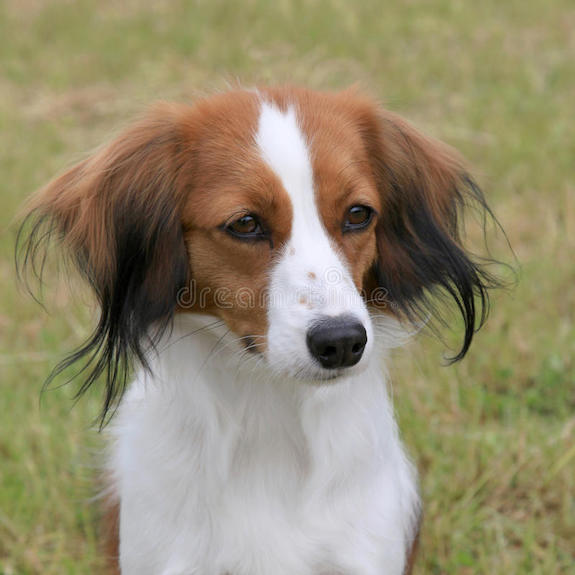
The Nederlandse Kooikerhondje is a fascinating breed with deep roots: It has been easily dated back to the 17th century. Our interest in the breed for this post, however, focuses on its color and an interesting “factoid” that may or may not be true. Our romantic side hopes that it is.
The present day AKC breed standard indicates that distinct patches of clear orange-red on pure white are ideal in this breed. Oh, a few small spots on the legs or muzzle are acceptable, but the majority of the dog’s chest, belly, legs and tail should be white. Furthermore, an orange red color should predominate on the dog’s head and torso, and this may be present as a mantle or blanket. Some black hair intermingling with the orange-red color, and a slight form of ticking are okay, but desirable? Not so much. As for the head, there should be coloring on the cheeks ideally ending at the corner of the Kooiker’s mouth, oh, and around the eyes, too.
Occasionally, a tri colored puppy will be born in a litter, and the breed standard goes on to indicate that a Kooiker that is black and white or tri-colored should be disqualified from consideration in a show ring. Why is this interesting?
Because according to modern legend, the Dutch (and this is a Dutch breed) decided to disqualify the tri-color during WWII to irritate the Germans by making orange and white color the acceptable color, why? Because orange was, and is, the national color of the Netherlands.
True or not, we’re partial to hearing that a country of origin had the last word (and the last laugh) about their own breed.
Image: Nederlandse Kooikerhondje by © Radomír Režný | Dreamstime.com

In order to re-create the breed, as it appeared on paintings from the 17th century, Brsse. van Hardenbroek van Ammerstol, the lady that could be considered the “mother” of the breed, started around 1940 (at the beginning of WWII) collecting look-a-likes, by sending a travelling salesman with a lock of hair and a picture of the dogs on the paintings through the Netherlands, to start her breeding programme. In 1942 she bred the first litter, with “Tommie” who was her best looking female. As the Kooiker is supposed to have “ear rings”, the longer black hair plumes on the earlaps, it is important that the breed should have the genetic factor for the color black. It looked as if more and more the “ear rings” went missing in the litters and so it was decided to do an outcross with a tri-colored Cavalier King Charles Spaniel. At first there were some tri-colored pups in the following litters, but she succeded in maintaining the “ear rings” and loosing the tri-color. I never heared about the fact that the orange colour was to irritate the Germans, however, Willem van Oranje, who is the ancestor of our Royals, was said to have owned a little dog, that was supposed to be a Kooikerhondje or a at least a little Spaniel type dog. The story tells that the dog saved his life by waking him up when his camp was raided by Spanish troups so he could escape in time. So there wás a connection with the House of Orange. If that was the thought behind recreating the breed, i don’t know. Fact is that the Kooikerhondje is one of the jewels in the crown of the Dutch Dog Breeds. 🙂
Many thanks for adding to the narrative about this marvelous breed, Elly! Very interesting information you’ve shared.